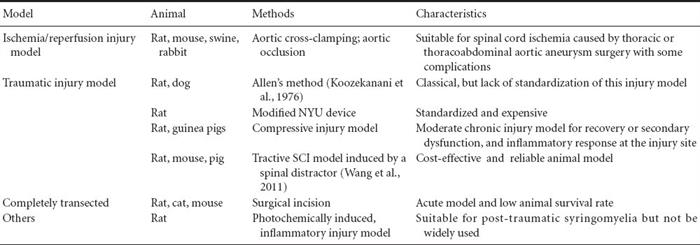In the US alone, 17,700 new spinal cord injury (SCI) cases occur each year.1 Males between 16 and 30 are at the highest risk of SCI although adults over 65 also have elevated risk, as well as those who suffer from a bone or joint disorder.2 SCI involves damage to the central nervous system or nerve fibers caused by incidents like vehicle accidents, falls, sport or recreational activities, violent actions, and disease.2 Patients of SCI can suffer symptoms including paralysis, reduced sensation, spasms, pain, reduced respiratory function, incontinence, or changes in sexual function.2
Immediate treatment typically involves maintaining critical bodily function, ensuring no further damage occurs, and attempting to avoid complications.2 Depending on the severity of injury, patients may then take medication, undergo surgery to repair damaged areas, use traction or other devices to maintain proper alignment of the spine and neck, or engage in experimental treatments.2 Most patients will have some level of rehabilitation therapy which covers physical therapy, occupational therapy, nutrition, and more. However, many patients never regain normal function or movement abilities.
Research to better understand the side effects of SCI and identify improved treatment options is ongoing.
Creating Animal Models of SCI
SCI presents similarly in animals as it does in humans, but the wide variety of human injury types presents a challenge in creating effective animal models. Despite these challenges, animal models including rodents, canines, rabbits, swine, and primates have helped uncover key insights into SCI and provided translational research resulting in new therapies. A 2014 publication in the journal Neural Regeneration Research cites the following conditions as necessary for an adequate animal model “(1) simulate damage that is similar to clinical SCI; (2) be controlled, reproducible, and stable; (3) involve a simple technique that is easy to study; (4) the equipment used to make a model is straightforward and quick to produce”.3
Several SCI models exist which can be used in various animals including ischemia-reperfusion injury, traumatic injury, transection, and more. The table below shows each of these models, the types of animals they are typically used in, how they are created, and characteristics of the model.3

Publications
Angiotensin-(1-7) Receptor Mas in Hemodynamic and Thermoregulatory Dysfunction After High-Level Spinal Cord Injury in Mice: A Pilot Study
When SCI occurs above the mid-thoracic levels, patients often experience cardiovascular and thermoregulatory issues due to autonomic dysfunction. This research team believed the Mas receptor may be a good target for SCI treatment as it is part of the renin-angiotensin system (RAS) which regulates blood pressure. Specifically, they wanted to see if blocking Mas would cause a more severe response. They ran a pilot study using DSI implantable telemetry to characterize acute and chronic hemodynamic reaction to SCI in a mouse model. The results indicated Mas deficient mice were more resistant to acute hypotension, delayed nocturnal recovery, lower activity and more severely impaired thermoregulation. Future studies are required to identify the underlying mechanisms for differences in the absence of Mas.4
Intermittent hypoxia promotes recovery of respiratory motor function in spinal cord-injured mice depleted of serotonin in the central nervous system
As intermittent hypoxia is known to increase respiratory motor activity in healthy animals and humans, this research team wanted to see what effect it may have on recovery of respiratory and limb motor function in a mouse SCI model genetically depleted of central nervous system serotonin. The team used DSI telemetry and respiratory solutions to measure EEG, temperature, locomotor activity, tidal volume, and breathing frequency. They also measured diaphragm activity, ventilation, and limb mobility throughout the experiment. The mice were exposed to intermittent hypoxia for four minutes twelve times per day for ten days. The team saw improvements in diaphragm activity, tidal volume, and breathing frequency. Although they also saw improvement in limb motor function, it was not believed to be dependent on intermittent hypoxia or serotonin levels. They concluded that intermittent hypoxia supports the recovery of respiratory function but not basic motor tasks.5
The Therapeutic Effectiveness of Delayed Fetal Spinal Cord Tissue Transplantation on Respiratory Function Following Mid-Cervical Spinal Cord Injury
Impairment of the respiratory system is the most common cause of morbidity and death in SCI patients. This study aimed to investigate the therapeutic potential of delayed transplantation of fetal spinal cord (FSC) tissue to improve respiratory function in a rat model. The research team transplanted FSC tissue one week after inducing injury and saw their full result eight weeks later. Throughout the study, the research team measured respiratory endpoints including frequency, tidal volume, and minute ventilation using DSI’s whole body plethysmography (WBP). The study’s results indicate fetal spinal cord tissue transplantation may be able to repair SCI and improve respiratory function.6
Approaches to studying SCI
Telemetry
DSI’s PhysioTel telemetry solutions enable researchers to assess the physiologic effects of SCI and evaluate potential new treatments. Available endpoints include biopotentials (EEG, EMG, ECG), blood pressure, blood glucose, diaphragmatic EMG, and more. Telemetry allows for continuous measurement of these endpoints in conscious, freely moving animals, improving animal welfare and providing higher quality data than tethered or anesthetized methods.
Respiratory
DSI’s Buxco respiratory solutions allows researchers to understand the impact of SCI on the respiratory system and evaluate treatments to improve respiratory function. Researchers can collect endpoints such as respiratory rate, tidal volume, resistance, compliance, and more. Whole body plethysmography, specifically, is often used to measure muscle weakness in the diaphragm. This approach is particularly useful to SCI researchers as it can be combined with telemetry or hardwired (tethered) methods to obtain additional cardiovascular, neurological, or other endpoints.
Behavioral
DSI’s physiologic monitoring solutions can be used in combination with various behavioral assessment tools from other Harvard Bioscience companies to get a full picture of the injury and its effects. Below are a few examples of such products along with citations of SCI studies that have used them.
Visit Harvard Apparatus’ website for additional information.
Are you performing spinal cord injury research? We’d love to hear what methods you are currently using, what’s going well, and what challenges you face. Schedule a call with us and let’s work together to develop a plan ensuring you get the most out of your experiments.

Interested in an additional example of SCI research conducted with DSI solutions? Check out this case study where researchers assess a potential treatment in a conscious rat model.
References
1National Spinal Cord Injury Statistical Center. (2018). “Spinal Cord Injury Facts and Figures at a Glance” https://www.nscisc.uab.edu/Public/Facts%20and%20Figures%20-%202018.pdf
2Mayo Clinic Staff. (2019). “Spinal Cord Injury”. Mayo Clinic. https://www.mayoclinic.org/diseases-conditions/spinal-cord-injury/symptoms-causes/syc-20377890
3Zhang N, Fang M, Chen H, Gou F, Ding M. (2014). “Evaluation of spinal cord injury animal models”. Neural Regeneration Research, 9(22): 2008-2012. https://dx.doi.org/10.4103%2F1673-5374.143436
4Jarve A, Todiras M, Kny M, Fischer F, Kraemer J, Wessel N, Plehm R, Fieltz J, Alenina N, Bader M. (2019). “Angiotensin-(1-7) Receptor Mas in Hemodynamic and Thermoregulatory Dysfunction After High-Level Spinal Cord Injury in Mice: A Pilot Study”. Frontiers in Physiology. https://doi.org/10.3389/fphys.2018.01930
5Komnenov D, Solarewicz JZ, Afzal F, Nantwi KD, Kuhn DM, Mateika JH. (2016). “Intermittent hypoxia promotes recovery of respiratory motor function in spinal cord-injured mice depleted of serotonin in the central nervous system”. Journal of Applied Physiology, 121(2): 545-557. https://doi.org/10.1152/japplphysiol.00448.2016
6Lin CC, Lai SR, Shao YH, Chen CL, Lee KZ. (2017). “The Therapeutic Effectiveness of Delayed Fetal Spinal Cord Tissue Transplantation on Respiratory Function Following Mid-Cervical Spinal Cord Injury”. Neurotherapeutics, 14(3): 792-809. https://link.springer.com/article/10.1007/s13311-016-0509-4